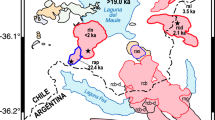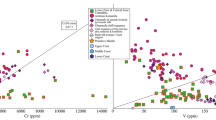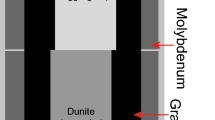Abstract
The paper reports data on the chemical composition of mantle peridotite xenoliths from kimberlites and alkaline basalts that represent the continental lithospheric mantle (CLM) beneath Early Precambrian and Late Proterozoic-Cenozoic structures, respectively. In order to identify compositional trends during the melting of primitive material and propose the most reliable criteria for constraining the conditions of this process and its degree, we analyzed literature data on the melting of spinel and garnet peridotites within broad temperature and pressure ranges. It was determined that the degree of melting (F%) of pristine peridotite of composition close to that of the primitive mantle (PM) can be deduced from the Mg/Si and Al/Si ratios in the residue; an equation was proposed for evaluating F from the Mg/Si ratio. The Ca/Al ratio of residues at low (1–1.5 GPa) pressures and degrees of melting from 2–3 to 20–25% increases several times but decreases with increasing F at pressures higher than 3 GPa. The Na partition coefficient between melt and residue decreases at increasing pressure and approaches one at a pressure close to 20 GPa. Residues after low-degree melting are strongly depleted in Ti, Zr, Y, and Nb but are enriched in Cr. The application of these criteria to the composition of xenoliths brought to the surface from the mantle occurring beneath tectonic structures of various age led us to conclude that compositional heterogeneities of CLM (particularly the variations in the concentrations of major and certain siderophile elements) are controlled, first of all, by the melting of the mantle source material. These processes occurred under various thermodynamic conditions (T, P, and \( f_{O_2 } \)) and differed in their intensity, and this predetermined the compositional diversity of the residual mantle material (its concentrations of Mg, Al, Si, Ca, Na, K, Ni, Co, V, and Cr). Our results are principally consistent with the hypothesis of the global magmatic ocean. It is thought that the early phases of its consolidation were variably controlled by the fractionation of minerals, for example, majorite. Moreover, heterogeneities in the distribution of siderophile elements could be partly predetermined by changes in the properties of these elements at ultrahigh temperatures and pressures. The processes of partial melting were the most intense during the early evolution of the mantle (perhaps, in the Early Precambrian), and hence, the mantle has different chemical composition beneath Archean cratons and Phanerozoic foldbelts.
Similar content being viewed by others
References
F. R. Boyd, N. P. Pokhilenko, D. G. Pearson, et al., “Composition of the Siberian Cratonic Mantle: Evidence from Udachnaya Peridotite Xenoliths,” Contrib. Mineral. Petrol. 128, 228–246 (1997).
F. R. Boyd, D. G. Pearson, and S. A. Mertzman, “Spinel-Facies Peridotites from the Kaapvaal Root,” in Proc. VIIth Int. Kimb. Conf. (Roof Design, Cape Town, 1999), Vol. 1, pp. 40–48 (1999).
W. L. Griffin, S. Y. O’Reilly, C. G. Ryan, C. G. Gaul, and D. Ionov, “Secular Variation in the Composition of Subcontinental Lithospheric Mantle,” in Structure and Evolution of the Australian Continent, Ed. by J. Braun, Am. Geophys. Un. Geodynam. Ser. 26, 1–26 (1998).
W. L. Griffin, C. G. Ryan, F. V. Kaminsky, et al., “The Siberian Lithosphere Traverse: Mantle Terranes and Assembly of the Siberian Craton,” Tectonophysics 310, 1–35 (1999).
V. A. Glebovitskii, L. P. Nikitina, N. O. Ovchinnikov, et al., “Upper Mantle beneath Archean Cratons: Thermal States, Chemical Composition, Degree of Melting: Evidence from Deep-Seated Xenoliths,” in “Problems of Sources of Deep-Seated Magmatism and Plumes,” Ed. by N.V. Vladykin (Nauka, Irkutsk, 2005) [in Russian].
V. A. Glebovitskii, L. P. Nikitina, N. O. Ovchinnikov, et al., “Geochemistry of Mantle Xenoliths from Kimberlites and Alkali Basalts as an Indication of the Compositional Heterogeneity of the Continental Lithospheric Mantle,” in Deep-Seated Magmatism and Its Sources, Ed. by N. V. Vladykin (Nauka, Irkutsk, 2005) [in Russian].
M. J. Walter, “Melt Extraction and Compositional Variability in Mantle Lithosphere,” in Treatise on Geochemistry (Elsevier, 2003), Vol. 2, 363–394.
V. C. Bennett, “Compositional Evolution of the Mantle, in Treatise on Geochemistry (Elsevier, 2003), Vol. 2, pp. 493–519.
S. A. Wilde, J. W. Valley, W. H. Peck, and C. M. Graham, “Evidence from Detrital Zircons for the Existence of Continental Crust and Oceans on the Earth 4.4 Gyr Ago,” Nature 409, 175–178 (2001).
J. A. C. Robinson, B. J. Wood, and J. D. Blundy, “The Beginning of Melting of Fertile and Depleted Peridotites at 1.5 GPa,” Earth Planet. Sci. Lett. 155, 97–111 (1998).
M. J. Walter, “Melting of Garnet Peridotite and the Origin of Komatiite and Depleted Lithosphere,” J. Petrol. 39, 29–60 (1998).
J. Pickering-Witter and A. D. Johnston, “The Effects of Variable Bulk Composition on the Melting Systematics of Fertile Peridotitic Assemblages,” Contrib. Mineral. Petrol. 140, 190–211 (2000).
B. E. Schwab and A. D. Johnston, “Melting Systematics of Modally Variable Compositionally Intermediate Peridotites and the Effects of Mineral Fertility,” J. Petrol. 42(10), 1789–1811 (2001).
R. G. Tronnes and D. J. Frost, “Peridotite Melting and Mineral-Melt Partitioning of Major and Minor Elements at 22–24.5 GPa,” Earth Planet. Sci. Lett. 197, 117–131 (2002).
H. Palme and H. St. C. O’Neill, “Geochemical Estimates of Mantle Composition,” in Treatise on Geochemistry (Elsevier, 2003), Vol. 2, pp. 1–38.
E. Jagoutz, H. Palme, H. Baddenhausen, K. Blum, et al., “The Abundances of Major, Minor and Trace Elements in the Earth’s Mantle as Derived from Primitive Ultramafic Nodules,” Proc. Lunar Planet. Sci. Conf. 10, 2031–2050 (1979).
S. R. Hart and G. A. Zindler, “In Search of a Bulk-Earth Composition,” Chem. Geol. 57, 247–267 (1986).
S. R. Taylor and S. M. McLennan, The Continental Crust: Its Composition and Evolution (Blackwall Sci. Publ, Oxford, 1985).
F. Bonatti, G. Ottonello, and P. R. Hamlyn, “Peridotites from the Island of Zabargad (St. John), Red See: Petrology and Geochemistry,” J. Geophys. Res. 91, 599–631 (1986).
W. F. McDonough and S.-S. Sun, “The Composition of the Earth,” Chem. Geol. 120, 223–253 (1995).
M. Chen, A. El Goresy, D. Frost, and P. Gillet, “Melting Experiments of a Chondritic Meteorite between 16 and 25 GPa: Implication for Na/K Fractionation in Primitive Chondritic Earth’s Mantle,” Eur. J. Mineral. 16, 203–211 (2004).
A. D. Johnston and B. Schwab, “Constraints on Clinopyroxene/ Melt Partitioning of REE, Rb, Sr, Ti, Cr, Zr and Nb during Mantle Melting: First Insight from Peridotite Melting Experiments at 1.0 GPa,” Geochim. Cosmochim. Acta 68(23), 4949–4962 (2004).
V. A. Glebovitsky, L. P. Nikitina, V. Ya. Khiltova, and N. O. Ovchinnikov, “The Thermal Regimes of the Upper Mantle beneath Precambrian and Phanerozoic Structures up to the Thermobarometry Data of Mantle Xenoliths,” Lithos 74, 1–26 (2004).
V. A. Glebovitskii, L. P. Nikitina, A. K. Saltykova, et al., “Thermal and Chemical Heterogeneity of the Upper Mantle beneath the Baikal-Mongolia Territory,” Petrologiya 15(1), 61–92 (2007) [Petrology 15, 58–89 (2007)].
D. A. Ionov, I. V. Ashchepkov, H. G. Sosch, et al., “Xenoliths of Garnet Peridotites of the Vitim Volcanic Field of the Transbaikalia: Petrology and Geochemistry of Garnet-Spinel Transition Zone of Subcontinental Mantle,” in Magmatism of Rifts and Fold Belts, Ed. by O. A. Bogatikov (Nauka, Moscow, 1993) [in Russian].
D. A. Ionov, H. G. Stosch, V. I. Kovalenko, et al., “Upper Mantle Evolution in the Southern Part of the Baikal Rift Zone Based as Implied by the Sr and Nd Isotopic Composition of the Xenoliths from the Bartoi Volcanoes,” in Magmatism of Rifts and Foldbelts, Ed. by O. A. Bogatikov (Nauka, Moscow, 1993) [in Russian].
A. V. Ukhanov, I. D. Ryabchikov, and A. D. Khar’kiv, Lithospheric Mantle of the Yakutian Kimberlite Province (Nauka, Moscow, 1988) [in Russian].
R. W. Carlson, A. J. Irving, and B. C. Hearn, Jr., “Chemical and Isotopic Systematics of Peridotite Xenoliths from the Williams Kimberlite, Montana: Clues to Processes of Lithosphere Formation, Modification and Destruction,” in Proc. VIIth Int. Kimb. Conf. (Roof Design, Cape Town, 1999), Vol. 1, pp. 90–96 (1999).
M. Gregorie, D. R. Bell, and A. P. Le Roex, “Garnet Lherzolites from the Kaapvaal Craton (South Africa): Trace Element Evidence for a Metasomatic History,” J. Petrol. 44(4), 629–657 (2003).
D. A. Ionov, “Chemical Variations in Peridotite Xenoliths from Vitim, Siberia: Inferences for REE and Hf Behaviour in the Garnet-Facies Upper Mantle,” J. Petrol. 45, 343–367 (2004).
E. Takahashi, “Melting of a Dry Peridotite KLB-1 up to 14 GPa: Implication on the Origin of Peridotitic Upper Mantle,” J. Geophys. Res. 91, 15941–15954 (1986).
A. L. Jaques, H. St. C. O’Neill, C. B. Smith, et al., “Diamondiferous Peridotite Xenoliths from the Argyle (AK1) Lamproite Pipe, Western Australia,” Contrib. Mineral. Petrol. 104, 255–276 (1990).
M. G. Kopylova and J. K. Russel, “Chemical Stratification of Cratonic Lithosphere: Constraint from the Northern Slave Craton, Canada,” Earth Planet. Sci. Lett. 181, 71–87 (2000).
M. G. Kopylova, J. K. Russell, and H. Cookenboo, “Mapping the Lithosphere beneath the North Central Slave Craton,” in Proc. VIIth Int. Kimb. Conf. (Roof Design, Cape Town, 1999), Vol. 1, pp. 468–479 (1999).
J. M. MacKenzie and D. Canil, “Composition and Thermal Evolution of Cratonic Mantle beneath the Central Archean Slave Province, NWT, Canada,” Contrib. Mineral. Petrol. 134, 313–324 (1999).
P. Peltonen, H. Huhma, M. Tuni, and N. Shimizu, “Garnet Peridotite Xenoliths from Kimberlites of Finland: Nature of the Continental Mantle at the Archean Craton-Proterozoic Mobile Belt Transition,” in Proc. 7th Int. Kimb. Conf. (Roof Design, Cape Town, 1999), Vol. 2, 664–676 (1999).
S. Press, G. Witt, H. A. Seck, et al., “Spinel Peridotite Xenoliths from the Tariat Depression, Mongolia,” Geochim. Cosmochim. Acta 50, 2587–2600 (1986).
Q. Qi, A. Lawrence, L. A. Taylor, and X. Zhou, “Petrology and Geochemistry of Mantle Peridotite from SE China,” J. Petrol. 36(1), 55–79 (1995).
S. S. Rai and P.V.S.S. Sarma Rajgopala, K.S. Prakasam, and V. K. Rao, “Seismic Evidence for Thick and Underplated Late Archean Crust of Eastern Dharvar Craton,” Proc. Indian Acad. Sci. (Earth Planet. Sci.) 105(4), 431–439 (1996).
S. S. Schmidberger and D. Francis, “Nature of the Mantle Root beneath the North American Craton: Mantle Xenolith Evidence from Somerset Island Kimberlites,” Lithos 48, 195–217 (1999).
S. S. Schmidberger and D. Francis, “Constraints on the Trace Element Composition of the Archean Mantle Root Beneath Somerset Island, Arctic Canada,” J. Petrol. 42(6), 1095–1117 (2001).
H. G. Stosch, G. W. Lugmair, and V. I. Kovalenko, “Spinel Peridotite Xenoliths from the Tariat Depression, Mongolia. II. Geochemistry and Nd and Sr Isotopic Composition and Their Implications for the Evolution of the Subcontinental Lithosphere,” Geochim. Cosmochim. Acta 50, 2601–2614 (1986).
U. Wiechert, D. A. Ionov, and K. H. Wedepohl, “Spinel Peridotite Xenoliths from Atsagin-Dush Volcano, Dariganga Lava Plateau, Mongolia: A Record of Partial Melting and Cryptic Metasomatism in the Upper Mantle,” Contrib. Mineral. Petrol. 126, 345–364 (1997).
X. Xu, S. Y. O’Reilly, W. L. Griffin, and X. Zhou, “Genesis of Young Lithospheric Mantle in SE China,” J. Petrol. 41, 111–148 (2000).
X. Xu, S. Y. O’Reilly, W. L. Griffin, and X. Zhou, “Enrichment of Upper Mantle Peridotite: Petrological, Trace Element and Isotopic Evidence in Xenoliths from SE China,” Chem. Geol. 198, 163–188 (2003).
E. M. Klein, “Geochemistry of the Igneous Oceanic Crust,” in Treatise on Geochemistry (Elsevier, Amsterdam, 2003), Vol. 3, pp. 433–463.
G. L. Farmer, “Continental Basaltic Rocks,” in Treatise on Geochemistry (Elsevier, 2003), Vol. 3, pp. 85–121 (2003).
E. Takazawa, E. A. Frey, N. Shimizu, and M. Obata, “Whole Rock Compositional Variations in an Upper Mantle Peridotite (Horoman, Hokkaido, Japan): Are They Consistent with a Partial Melting Process,” Geochim. Cosmochim. Acta 64(4), 695–716 (2000).
V. A. Glebovitskii, L. P. Nikitina, A. K. Saltykova, et al., “Compositional Heterogeneity of the Continental Lithospheric Mantle beneath the Early Precambrian and Phanerozoic Structures: Evidence from Mantle Xenoliths in Kimberlites and Alkaline Basalts,” Geokhimiya, No. 11, 1169–1194 (2007) [Geochem. Int. 45, 1077–1102 (2007)].
R. V. Carlson, “Introduction to Volume 2,” in Treatise on Geochemistry (Elsevier, 2003), Vol. 2, pp. XV–XXI.
A. B. Vrevskii, V. A. Matrenichev, and M. S. Ruzh’eva, “Petrology of Komatiites of the Baltic Shield and Isotopic-Geochemical Evolution of Their Mantle Sources,” 11(6), 587–617 (2003) [Petrology 11, 1077–1102 (2003)].
D. G. Pearson, D. Canil, and S. B. Shirey, “Mantle Samples Included in Volcanic Rocks: Xenoliths and Diamonds,” in Treatise on Geochemistry (Elsevier, 2003), Vol. 2, pp. 172–270.
D. Canil, “Vanadium in Peridotites, Mantle Redox and Tectonic Environment: Archean to Present,” Earth Planet. Sci. Lett. 195, 75–90 (2002).
W. R. Taylor, M. Kamperman, and R. Hamilton, “New Thermobarometer and Oxygen Fugacity Sensor Calibrations for Ilmenite- and Chromian Spinel-Bearing Peridotitic Assemblages,” in Proc. VIIth Int. Kimb. Conf. (Roof Design, Cape Town, 1999), pp. 891–892 (1999).
I. T. Bryndzia and B. J. Wood, “Oxygen Thermobarometry of Abyssal Spinel Peridotites: Redox State and C-O-H Volatile Composition of the Earth’s Sub-Oceanic Upper Mantle,” Am. J. Sci. 290, 1093–1116 (1990).
L. P. Nikitina and M. V. Ivanov, Geological Thermobarometry Based on Mineral-Forming Reaction with the Participation of Phases of Variable Composition (Nedra, St. Petersburg, 1992) [in Russian].
L. P. Nikitina, “Garnet-Orthopyroxene and Garnet-Clinopyroxene Thermobarometers for Mantle Xenoliths,” in Capricious Earth: Models and Modeling of Geologic Processes and Objects, Ed. by V. A. Glebovitsky and V. N. Dech (Theophrastus Contribution to Advanced Studied in Geology) (St. Petersburg, Athens, 2000), pp. 44–53.
P. B. Kelemen, H. J. B. Dick, and J. E. Quick, “Formation of Harzburgite by Pervasive Melt/Rock Reaction in the Upper Mantle,” Nature 358, 635–641 (1992).
Yu. A. Kostitsyn, “Terrestrial and Chondritic Sm-Nd and Lu-Hf Isotopic Systems: Are They Identical?,” Petrologiya 12(5), 451–466 (2004) [Petrology 12, 397–411 (2004)].
Yu. D. Pushkarev, L. P. Nikitina, and V. I. Skiba, “Xenoliths of Primitive Mantle as Material of MORB Source: Identification, Estimation, and Values of Sm-Nd and Rb-Sr,” in Problems of Sources of Deep-Seated Magmatism and Plumes (Nauka, Irkutsk, 2005), pp. 98–115 [in Russian].
K. Righter and M. J. Drake, “Partition Coefficients at High Pressure and Temperature,” in Treatise on Geochemistry (Elsevier, 2003), Vol. 2, pp. 425–449.
J. Li and C. B. Agee, “Geochemistry of Mantle-Core Formation at High Pressure,” Nature 381, 686–689 (1996).
J. Li and C. B. Agee, “The Effect of Pressure, Temperature, Oxygen Fugacity and Composition on Partitioning of Nickel and Cobalt between Liquid Fe-Ni-S Alloy and Liquid Silicate: Implications for the Earth’s Core Formation,” Geochim. Cosmochim Acta 65, 1821–1832 (2001).
E. Ito, T. Katsura, and T. Suzuki, “Metal/Silicate Partitioning of Mn, Co, and Ni at High Pressures and High Temperatures and Implications for Core Formation in a Deep Magma Ocean,” in Properties of Earth and Planetary Materials at High Pressure and Temperature, Ed. by M. H. Mahghnani, Geophys. Monogr. 101 (AGU, Washington, 1998), pp. 215–225.
K. Righter and M. J. Drake, “Metal-Silicate Equilibrium in a Homogeneously Accreting Earth: New Results for Re,” Earth Planet. Sci. Lett. 146, 149–167 (1997).
N. L. Chabot and C. B. Agee, “Core Formation in the Earth and Moon: New Experimental Constraints from V, Cr, and Mn,” Geochim. Cosmochim. Acta 67, 2077–2091 (2003).
M. Akaogi and S. Akimoto, “Pyroxene-Garnet Solid-Solution in the Systems Mg4SiO4O12-Mg3Al2O12 and Fe4SiO4O12-Fe3Al2O12 at High Pressures and Temperatures,” Phys. Earth Planet. Inter. 15, 99–106 (1977).
H. Yurimoto and E. Ohtani, “Element Partitioning between Majorite and Liquid: A SIMS Study,” Geophys. Res. Lett. 19, 17–20 (1992).
N. P. Pokhilenko, N. V. Sobolev, J. A. MacDonald, et al. “Crystalline Inclusions in Diamonds from Kimberlites of the Snap Lake Area (Slave Craton, Canada): New Evidences for the Anomalous Lithospheric Structure,” Doklady Akademii Nauk 380(3), 374–379 (2001) [Dokl. Earth Sci. 380, 806–811 (2001)].
A. V. Sobolev, A. W. Hofmann, D. V. Kuzmin, et al., “The Amount of Recycled Crust in Sources of Mantle- Derived Melts,” Science 316, 412–417 (2007).
Author information
Authors and Affiliations
Corresponding author
Additional information
Original Russian Text © V.A. Glebovitsky, L.P. Nikitina, A.B. Vrevskii, Yu.D. Pushkarev, M.S. Babushkina, A.G. Goncharov, 2009, published in Geokhimiya, 2009, No. 9, pp. 910–936.
Rights and permissions
About this article
Cite this article
Glebovitsky, V.A., Nikitina, L.P., Vrevskii, A.B. et al. Nature of the chemical heterogeneity of the continental lithospheric mantle. Geochem. Int. 47, 857–881 (2009). https://doi.org/10.1134/S001670290909002X
Revised:
Published:
Issue Date:
DOI: https://doi.org/10.1134/S001670290909002X




